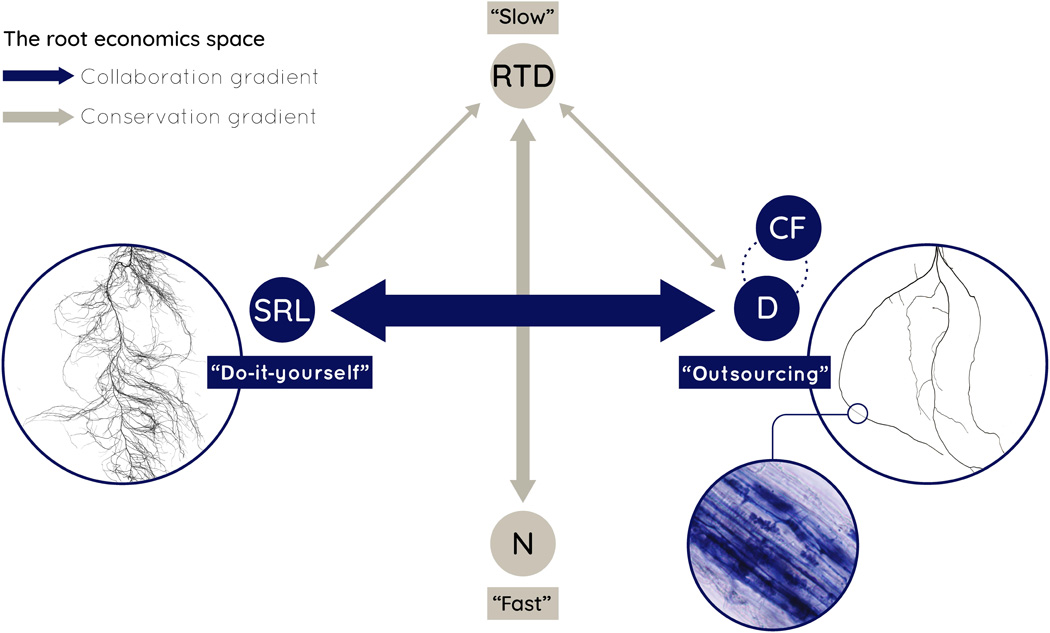July 01, 2020
The Fungal Collaboration Gradient Dominates Root Economics Space in Plants
Reimagining belowground plant resource acquisition

The multidimensional ‘Root Economics Space’ describes tradeoffs in root characteristics, or traits, that allows plants to optimize belowground resource acquisition. RTD is root tissue density, N is root nitrogen concentration, SRL is specific root length and D is root diameter.
[Reprinted under a Creative Commons Attribution-NonCommercial 4.0 International License (CC BY NC 4.0) from Bergman, J., et al. "The Fungal Collaboration Gradient Dominates the Root Economics Space in Plants." Science Advances 6(27), eaba3756. https://creativecommons.org/licenses/by-nc/4.0/]
The Science
A working group of belowground ecologists from around the world met three times over a period of two years at the German Centre for Integrative Biodiversity Research (iDiv) in Leipzig, Germany with an overarching goal of improving our understanding of how root traits vary among species and around the world. New understanding was based on the foundation of data compiled in the DOE-funded global Fine-Root Ecology Database (FRED), and the species-specific data subset of these data compiled in the Global Root Trait (GRooT) Database (Guerrero‐Ramírez et al. 2020).
The Impact
A fundamental ecological goal is to use easily-measured plant characteristics, traits, to predict plant function. Aboveground, ecologists use the ‘leaf economics spectrum’ of acquisitive to conservative leaf traits to predict photosynthesis and leaf lifespan across the world and in response to changing environmental conditions. The belowground ecologist working group investigated whether there is a parallel ‘root economics spectrum’ belowground that predicts plant resource acquisition based on root traits. Instead of a one-dimensional root economic spectrum that parallels leaves, the group found that a two-dimensional economic space was needed to encompass root resource acquisition strategies, because unlike leaves, roots have the ability to outsource resource acquisition to mycorrhizal fungi partners (Bergmann et al. 2020).
Summary
Plant economics run on carbon and nutrients instead of money. Leaf strategies aboveground span an economic spectrum from “live fast and die young” to “slow and steady,” but the economy defined by root strategies belowground remains unclear. Here, the belowground ecologist working group takes a holistic view of the belowground economy and show that root-mycorrhizal collaboration can short circuit a one-dimensional economic spectrum, providing an entire space of economic possibilities. Root trait data from 1810 species across the globe confirm a classical fast-slow “conservation” gradient but show that most variation is explained by an orthogonal “collaboration” gradient, ranging from “do-it-yourself” resource uptake to “outsourcing” of resource uptake to mycorrhizal fungi. This broadened “root economics space” provides a solid foundation for predictive understanding and model representation of belowground responses to changing environmental conditions.
Principal Investigator
Colleen Iversen
Oak Ridge National Laboratory
[email protected]
Program Manager
Daniel Stover
U.S. Department of Energy, Biological and Environmental Research (SC-33)
Environmental System Science
[email protected]
Funding
The Bergmann paper is a joint effort of the working group sROOT supported by sDiv, the Synthesis Centre of the German Centre for Integrative Biodiversity Research (iDiv) Halle-Jena-Leipzig, funded by the German Research Foundation (FZT 118). The sROOT workshops and L.M. were also supported by NWO-Vidi grant 864.14.006. J.B. was supported by DFG grants RI-1815/20-1 and RI 1815/22-1. C.M.I., M.L.M., and FRED were supported by the U.S. Department of Energy’s Office of Science, Biological and Environmental Research Program.
The GRooT initiative was possible owing to the support of the Synthesis Centre (sDiv) of the German Centre for Integrative Biodiversity Research (iDiv) Halle‐Jena‐Leipzig (DFG FZT 118) in the framework of the sRoot working group. We thank … A. Shafer Powell for assistance with FRED user guidance and data. Colleen M. Iversen and the Fine‐Root Ecology Database (FRED) are supported by the Biological and Environmental Research program in the Department of Energy’s Office of Science, and Joana Bergmann was supported by DFG grants RU‐1815/20‐1 and RI 1815/22‐1. Nathaly R. Guerrero‐Ramírez thanks the Dorothea Schlözer Postdoctoral Programme of the Georg‐August‐Universität Goettingen for their support; Nadejda A. Soudzilovskaia thanks vidi grant 016.161.318 issued by the Netherlands Organization for Scientific Research; and Vladimir G. Onipchenko thanks RSF for financial support (#16‐14‐10208). The study has been supported by the TRY initiative on plant traits (http://www.try‐db.org). The TRY initiative and database are hosted, developed and maintained at the Max Planck Institute for Biogeochemistry, Jena, Germany. TRY is currently supported by DIVERSITAS/Future Earth and the German Centre for Integrative Biodiversity Research (iDiv) Halle‐Jena‐Leipzig. Open access funding enabled and organized by Projekt DEAL.
References
Bergman, J., et al. "The Fungal Collaboration Gradient Dominates the Root Economics Space in Plants." Science Advances 6 (27), eaba3756 (2020). https://doi.org/10.1126/sciadv.aba3756.

